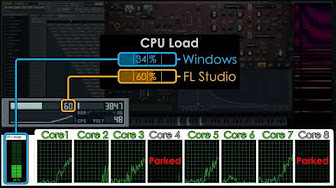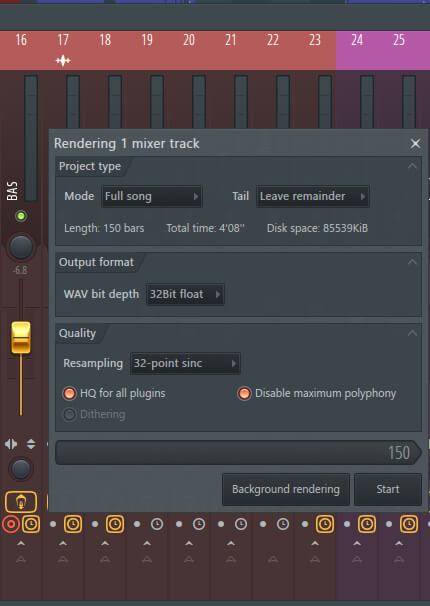Fl Studio Cpu Usage
FL Studio is the fastest way from your brain to speakers. Now the program interface is easy to scale for any screen resolution of your monitor. New, more convenient installation, sorting and launching VST plug-ins and tools. In the browser, new tabs and categories, as well as the ability to delete content with the right mouse button. FL Studio 20.0.4 Update for Windows and Mac We've significantly reduced CPU usage, added transpose for multiple instrument channels and patterns.
| Developer(s) | Image-Line Software (International) |
|---|---|
| Written in | Delphi |
| Operating system | Microsoft Windows |
| Type | Software synthesizer |
| License | Proprietary |
| Website | flstudio.com |
Sytrus is a software synthesizer included in the Digital Audio WorkstationFL Studio. Image-Line also released VSTi and DXi versions.
- 1Overview
Overview[edit]
Features[edit]
Sytrus uses a combination of subtractive synthesis, additive synthesis, FM synthesis and ring modulation, thus allowing sounds produced to range from drum sets to organs. Sytrus provides a large number of adjustments and controls, including shape shifting, harmonics editing, EQ, a modulator (which can control almost any parameter), several filters, reverb, delay, unison, detune, etc. CPU usage widely varies, mainly depending on effect settings, number of oscillators, and their settings.[1] The second version of Sytrus (introduced with FL Studio 6), comes with an array of presets covering many types of sounds.[2][3]
Easter eggs[edit]
When clicking on the Sytrus logo in 'Show Info', the Hint Bar at the top says 'Don't even think about it you fruit-clicking pervert!'. After several more clicks, it will say, 'Ok, fruit-clicking pays.' At this stage, the modulator grid changes to green rather than the standard blue. Then, 'There's nothing more, you know...'[citation needed]
See also[edit]
References[edit]
- ^'Sytrus'. Image-Line. Retrieved 2011-05-28.
- ^'Version History'. Image-Line. Retrieved 2011-05-28.
- ^'FL Studio Editions'. Image-Line. Retrieved 2011-05-28.
A good way to start investigating performance issues in your app is to understand its CPU usage. The CPU Usage performance tool shows the CPU time and percentage spent executing code in C++, C#/Visual Basic, and JavaScript apps.
The CPU Usage tool can run on an open Visual Studio project, on an installed Microsoft Store app, or attached to a running app or process. You can run the tool on local or remote machines, or on a simulator or emulator. For more information, see Run profiling tools with or without the debugger.
You can run the CPU Usage tool with or without debugging. In the debugger, you can turn CPU profiling on and off, and see a per-function breakdown of CPU usage. You can view CPU usage results when execution is paused, for example at a breakpoint.
The following instructions show how to use the CPU Usage tool without the debugger, using the Visual Studio Performance Profiler. The examples use a Release build on a local machine. Release builds provide the best view of actual app performance. To analyze CPU usage with Debug builds, see Beginner's guide to performance profiling.
Usually, the local machine best replicates installed app execution. For Windows Phone apps, collecting data directly from the device provides the most accurate data. To collect data from a remote device, run the app directly on the device, not over a Remote Desktop Connection.
Note
Windows 7 or later is required to use the Performance Profiler.
Collect CPU usage data
In the Visual Studio project, set the solution configuration to Release and select Local Machine as the deployment target.
Select Debug > Performance Profiler.
Under Available tools, select CPU Usage, and then select Start.
After the app starts, the diagnostic session begins and displays CPU usage data. When you're finished collecting data, select Stop Collection.
The CPU Usage tool analyzes the data and displays the report.
Analyze the CPU Usage report
The diagnostic report is sorted by Total CPU, from highest to lowest. Change the sort order or sort column by selecting the column headers. Use the Filter dropdown to select or deselect threads to display, and use the Search box to search for a specific thread or node.
Starting in Visual Studio 2019, you can click the Expand Hot Path and Show Hot Path buttons to see the function calls that use the highest percentage of the CPU in the call tree view.
CPU Usage data columns
| Total CPU [unit, %] | The milliseconds and CPU percentage used by calls to the function, and functions called by the function, in the selected time range. This is different from the CPU Utilization timeline graph, which compares the total CPU activity in a time range to the total available CPU. |
| Self CPU [unit, %] | The milliseconds and CPU percentage used by calls to the function in the selected time range, excluding functions called by the function. |
| Module | The name of the module containing the function. |
The CPU Usage call tree
To view the call tree, select the parent node in the report. The CPU Usage page opens to the Caller/Callee view. In the Current View dropdown, select Call Tree.
Call tree structure
| The top-level node in CPU Usage call trees is a pseudo-node. |
| In most apps, when the Show External Code option is disabled, the second-level node is an [External Code] node. The node contains the system and framework code that starts and stops the app, draws the UI, controls thread scheduling, and provides other low-level services to the app. |
| The children of the second-level node are the user-code methods and asynchronous routines that are called or created by the second-level system and framework code. |
| Child nodes of a method have data only for the calls of the parent method. When Show External Code is disabled, app methods can also contain an [External Code] node. |
External code
System and framework functions that are executed by your code are called external code. External code functions start and stop the app, draw the UI, control threading, and provide other low-level services to the app. In most cases, you aren't interested in external code, so the CPU Usage call tree gathers the external functions of a user method into one [External Code] node.

To view the call paths of external code, on the main diagnostic report page (right pane), select Show External Code from the Filter dropdown, and then select Apply. The Call Tree view of the CPU Usage page then expands the external code calls. (The Filter dropdown is available on the main diagnostic page, not the detailed views.)

Many external code call chains are deeply nested, so the width of the chain can exceed the display width of the Function Name column. The function names then appear as ....
To find a function name you're looking for, use the search box. Hover over the selected line or use the horizontal scroll bar to view the data.
Asynchronous functions in the CPU usage call tree
When the compiler encounters an asynchronous method, it creates a hidden class to control the method's execution. Conceptually, the class is a state machine. The class has compiler-generated functions that asynchronously call the original methods, and the callbacks, scheduler, and iterators needed to run them. When a parent method calls the original method, the compiler removes the method from the execution context of the parent, and runs the hidden class methods in the context of the system and framework code that controls app execution. The asynchronous methods are often, but not always, executed on one or more different threads. This code appears in the CPU Usage call tree as children of the [External Code] node immediately below the top node of the tree.
In the following example, the first two nodes under [External Code] are the compiler-generated methods of the state machine class. The third node is the call to the original method.
Expand the generated methods to show what's going on:
Fl Studio 12 Cpu Usage
MainPage::GetMaxNumberAsyncButton_Clickjust manages a list of the task values, computes the maximum of the results, and displays the output.MainPage+<GetMaxNumberAsyncButton_Click>d__3::MoveNextshows you the activity required to schedule and launch the 48 tasks that wrap the call toGetNumberAsync.MainPage::<GetNumberAsync>b__bshows the activity of the tasks that callGetNumber.
Comments are closed.